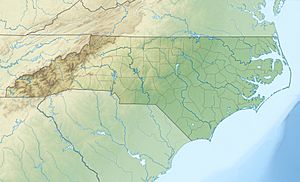Hurricane Creek (Brown Creek tributary) facts for kids
Quick facts for kids Hurricane Creek |
|
|---|---|
|
Location of Hurricane Creek mouth
|
|
| Other name(s) | Tributary to Brown Creek |
| Country | United States |
| State | North Carolina |
| County | Anson |
| Physical characteristics | |
| Main source | divide between Hurricane Creek and Grindstone Branch of Goulds Fork about 0.5 miles north of Pinkston, North Carolina 275 ft (84 m) 35°01′37″N 080°04′52″W / 35.02694°N 80.08111°W |
| River mouth | Brown Creek about 3.5 miles southeast of Ansonville, North Carolina 197 ft (60 m) 35°03′49″N 080°03′13″W / 35.06361°N 80.05361°W |
| Length | 3.74 mi (6.02 km) |
| Depth |
|
| Basin features | |
| Progression | northeast |
| River system | Pee Dee River |
| Basin size | 3.43 square miles (8.9 km2) |
| Tributaries |
|
| Bridges | Dennis Road |
Hurricane Creek is a small stream, about 3.74 miles (6.02 km) long, located in Anson County, North Carolina. It is a "first order tributary," which means it's a smaller stream that flows into a larger one. Hurricane Creek flows into Brown Creek. Brown Creek then flows into the Pee Dee River.
About Hurricane Creek
Hurricane Creek is an important part of the local water system in Anson County. It helps carry water from the land into larger rivers. This process is vital for the environment and local wildlife.
Where Hurricane Creek Starts and Ends
Hurricane Creek begins its journey about 0.5 miles (0.8 km) north of a place called Pinkston, North Carolina. This area is close to the Wadesboro airport. From there, the creek flows generally towards the northeast. It travels for about 3.74 miles (6.02 km) before it joins Brown Creek. This meeting point is about 3.5 miles (5.6 km) southeast of Ansonville, North Carolina.
The Land Around Hurricane Creek
The area that Hurricane Creek drains, known as its watershed, covers about 3.43 square miles (8.88 sq km). This means all the rain that falls in this area eventually flows into Hurricane Creek. The region gets a good amount of rain, about 47.9 inches (121.7 cm) each year. A large part of this watershed, about 53%, is covered by forests. These forests help keep the water clean and provide homes for many animals.



